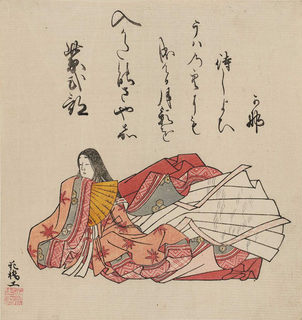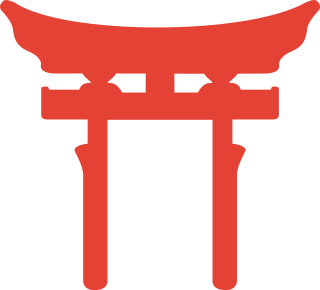 W
WThe Diary of Lady Murasaki is the title given to a collection of diary fragments written by the 11th-century Japanese Heian era lady-in-waiting and writer Murasaki Shikibu. It is written in kana, then a newly developed writing system for vernacular Japanese, more common among women, who were generally unschooled in Chinese. Unlike modern diaries or journals, 10th-century Heian diaries tend to emphasize important events more than ordinary day-to-day life and do not follow a strict chronological order. The work includes vignettes, waka poems, and an epistolary section written in the form of a long letter.
 W
WThe Kokin Wakashū , commonly abbreviated as Kokinshū (古今集), is an early anthology of the waka form of Japanese poetry, dating from the Heian period. It is an Imperial anthology, conceived by Emperor Uda and published by order of his son Emperor Daigo, in about 905. Its finished form dates to c. 920, though according to several historical accounts the last poem was added to the collection in 914. The compilers of the anthology were four court poets, led by Ki no Tsurayuki and also including Ki no Tomonori, Ōshikōchi no Mitsune, and Mibu no Tadamine.
 W
WThe letter from Koshigoe refers to a 12th century document written by Minamoto no Yoshitsune to Minamoto no Yoritomo from the city of Koshigoe.
 W
WThe Pillow Book is a book of observations and musings recorded by Sei Shōnagon during her time as court lady to Empress Consort Teishi during the 990s and early 1000s in Heian Japan. The book was completed in the year 1002.
 W
WThe Shoku Nihongi (続日本紀) is an imperially-commissioned Japanese history text. Completed in 797, it is the second of the Six National Histories, coming directly after the Nihon Shoki and followed by Nihon Kōki. Fujiwara no Tsugutada and Sugano no Mamichi served as the primary editors. It is one of the most important primary historical sources for information about Japan's Nara period.
 W
WThe Tale of Genji is a classic work of Japanese literature written in the early 11th century by the noblewoman and lady-in-waiting Murasaki Shikibu. The original manuscript, created around the peak of the Heian period, no longer exists. It was made in "concertina" or orihon style: several sheets of paper pasted together and folded alternately in one direction then the other. The work is a unique depiction of the lifestyles of high courtiers during the Heian period. It is written in archaic language and a poetic yet confusing style that make it unreadable to the average Japanese person without dedicated study. It was not until the early 20th century that Genji was translated into modern Japanese by the poet Akiko Yosano. The first English translation was attempted in 1882 but was of poor quality and incomplete.
 W
WThe Tale of the Bamboo Cutter is a 10th-century Japanese monogatari containing Japanese folklore. It is considered the oldest extant Japanese prose narrative, though the oldest surviving complete manuscript is dated to 1592.
 W
WThe Tale of the Heike is an epic account compiled prior to 1330 of the struggle between the Taira clan and Minamoto clan for control of Japan at the end of the 12th century in the Genpei War (1180–1185). Heike (平家) refers to the Taira (平), hei being the Sino-Japanese reading of the first Chinese character. Note that in the title of the Genpei War, "hei" is in this combination read as "pei" and the "gen" (源) is the first kanji used in the Minamoto clan's name.
 W
WThe Tosa Nikki is a poetic diary written anonymously by the tenth-century Japanese poet Ki no Tsurayuki. The text details a 55-day journey in 935 returning to Kyoto from Tosa province, where Tsurayuki had been the provincial governor. The prose account of the journey is punctuated by Japanese poems, purported to have been composed on the spot by the characters.